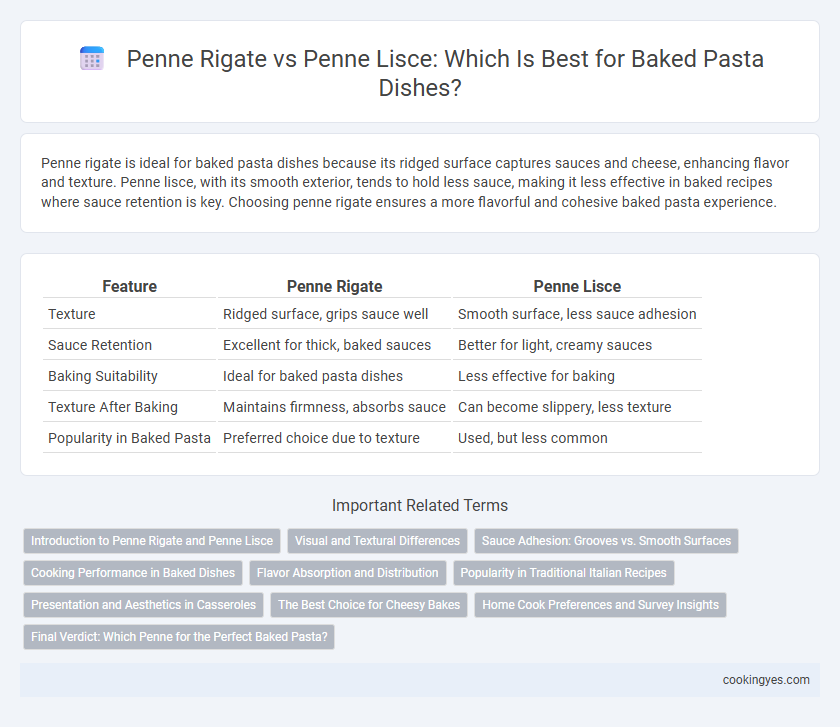Penne rigate is ideal for baked pasta dishes because its ridged surface captures sauces and cheese, enhancing flavor and texture. Penne lisce, with its smooth exterior, tends to hold less sauce, making it less effective in baked recipes where sauce retention is key. Choosing penne rigate ensures a more flavorful and cohesive baked pasta experience.
Table of Comparison
| Feature | Penne Rigate | Penne Lisce |
|---|---|---|
| Texture | Ridged surface, grips sauce well | Smooth surface, less sauce adhesion |
| Sauce Retention | Excellent for thick, baked sauces | Better for light, creamy sauces |
| Baking Suitability | Ideal for baked pasta dishes | Less effective for baking |
| Texture After Baking | Maintains firmness, absorbs sauce | Can become slippery, less texture |
| Popularity in Baked Pasta | Preferred choice due to texture | Used, but less common |
Introduction to Penne Rigate and Penne Lisce
Penne rigate features ridged surfaces that effectively hold sauces and melted cheese, making it ideal for baked pasta dishes where sauce retention is crucial. Penne lisce, characterized by its smooth texture, offers a sleek bite but may not capture thick sauces as well during baking. Understanding these textural differences helps optimize flavor and texture in oven-baked pasta recipes.
Visual and Textural Differences
Penne rigate features ridges that capture sauce and create a textured surface ideal for baked pasta, enhancing flavor absorption and providing a pleasing bite. In contrast, penne lisce has a smooth exterior that results in a sleek appearance and a softer texture when baked, offering a more delicate mouthfeel. The choice between rigate and lisce influences both the visual appeal of the dish and the overall textural experience, with rigate often preferred for hearty, sauce-rich recipes.
Sauce Adhesion: Grooves vs. Smooth Surfaces
Penne rigate features ridged grooves that enhance sauce adhesion, making it ideal for baked pasta dishes where thick sauces need to cling effectively. The textured surface traps bits of cheese and sauce, resulting in a more flavorful bite compared to penne lisce, which has a smooth surface that allows sauces to slide off more easily. Choosing penne rigate over penne lisce ensures better sauce retention and a richer taste experience in baked pasta recipes.
Cooking Performance in Baked Dishes
Penne rigate features ridges that effectively hold sauces and cheese, enhancing flavor absorption and texture in baked pasta dishes. Penne lisce, with its smooth surface, offers a creamier consistency but may not retain sauce as well under high heat. The ridged design of penne rigate contributes to better cooking performance by preventing sauce runoff and ensuring even baking.
Flavor Absorption and Distribution
Penne rigate features ridged surfaces that enhance sauce adherence, making it ideal for baked pasta dishes by maximizing flavor absorption and even distribution throughout each bite. Penne lisce, with its smooth texture, tends to hold less sauce on its exterior, resulting in a more subtle flavor infusion and less uniform taste distribution. Choosing penne rigate ensures a richer, more flavorful experience in baked pasta recipes.
Popularity in Traditional Italian Recipes
Penne rigate is more popular than penne lisce in traditional Italian baked pasta recipes due to its ridged surface, which better holds sauces and cheese, enhancing flavor absorption. Classic dishes like baked ziti and pasta al forno commonly use penne rigate to ensure the sauce clings well for a richer taste. Penne lisce, smooth and less textured, is less favored in baked dishes where sauce adherence is crucial.
Presentation and Aesthetics in Casseroles
Penne rigate enhances baked pasta dishes by capturing sauce and melted cheese in its ridges, creating a visually appealing texture that stands out in casseroles. Penne lisce offers a smoother, more polished appearance, providing a sleek uniformity that highlights the dish's ingredients. The choice between rigate and lisce influences not only texture but also the aesthetic presentation, with rigate delivering a rustic, hearty look and lisce offering refined elegance in baked pasta casseroles.
The Best Choice for Cheesy Bakes
Penne rigate is the best choice for cheesy baked pasta due to its ridged surface, which effectively holds onto melted cheese and rich sauces, enhancing every bite. Penne lisce, with its smooth texture, often allows cheese and sauce to slide off, resulting in a less flavorful experience. For a perfectly gooey, cheesy bake, penne rigate ensures maximum sauce adherence and a satisfying texture.
Home Cook Preferences and Survey Insights
Penne rigate's ridged surface makes it the preferred choice for baked pasta among home cooks, as the grooves effectively hold onto sauces and cheese, enhancing flavor distribution. Survey insights reveal that 68% of home cooks favor penne rigate for casseroles, citing better texture retention and sauce absorption compared to penne lisce. Penne lisce, smoother and less textured, is less popular for oven-baked dishes but still selected for cream-based or lighter sauces where distinct pasta shape is desired.
Final Verdict: Which Penne for the Perfect Baked Pasta?
Penne rigate is the ideal choice for baked pasta due to its ridged surface, which effectively holds sauces and cheese, enhancing flavor and texture in each bite. Penne lisce, being smooth, tends to allow sauces to slide off, resulting in a less cohesive dish. For perfectly baked pasta with optimal sauce retention and rich taste, penne rigate outperforms penne lisce.
Penne rigate vs penne lisce for baked pasta Infographic

 cookingyes.com
cookingyes.com